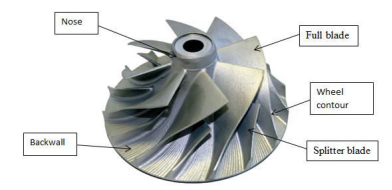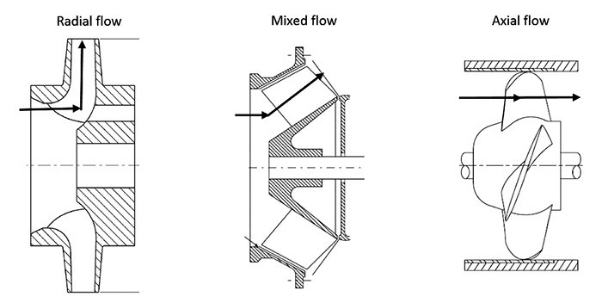Turbocharger Impeller CNC: From Design to Machining
 May 22,2025
May 22,2025

In modern engines, turbochargers are one of the main elements. They enhance power, fuel usage, and reduce emissions. In engines, turbo impellers, compressors and turbine wheels are essential for exhausting gas energy to compress air. It is important to understand the basic properties of material and how they are fabricated. Turbochargers work better, long-lasting and reliable if you understand them properly. This guide will highlight all the essential details about the turbo impeller design, pros and cons and applications.
What Is a Turbocharger Impeller?
It is an essential rotating part within a turbocharger which compresses the air coming inside the engine. The compression enhances the oxygen supply to engine and results in more fuel burning and torque and power boosting. The impeller design is aerodynamically efficient and can survive high pressure and heat.
Turbine Wheel and Compressor Wheel
Turbine impeller comprised of two parts turbine wheel and compressor when which are coupled together via shaft. The turbine wheel rotates by the exhaust gases in the engine and this rotation is transferred to the compressor wheel through the shaft. Air draws, compresses and then delivers to the engine by the compressor wheel which improves the combustion and power output
Difference: Impeller VS. Other Turbocharger Components
Impeller is a rotating wheel in a turbocharger that compresses the intake air. Whereas the other turbocharger components like turbine housing, compressor housing or turbine have distinct roles. Turbine drives the compressor impeller which takes power from exhaust gas and housings direct the gas flow.
How Does a Turbocharger Impeller Work?
Impeller is the heart of turbocharger and is located on its intake side. It draws in and compresses the air. This air then passes through the engine which allows for fuel combustion and high-power output. In short, the impeller is crucial for enhancing engine power.
How Turbocharger Impellers Improve Engine Efficiency
These are also called compressor wheels. By heavily compressing and forcing the air into the engine, the efficiency of engine increases and it enables it to produce the same power output with smaller displacement. This eventually increases the fuel economy and reduces emission.
How Impeller Speed and Flow Affect Power
The speed rate and flow rate in impeller is directly associated with the power requirements of pump. High speed and large diameters of impellers cause high flow rates which result in high power consumption. However, this relationship is not always linear.
Why Impeller Sizing Matters for Turbo Performance
Impeller sizing matters for turbo performance because it directly affects airflow, pressure boosting and engine power output. An optimized sized impeller has efficient airflow, high boost delivery, and prevents performance limitations such as excessive stress on engine or boost lag.
Turbocharger Impeller Design: Key Considerations
There are multiple factors that affect the design and performance of the turbocharger impeller. These are:
Factors Affecting Impeller Shape and Size
Impeller design is significantly affected by the blade shape and angle, diameter, width, curvature, and flow rate which overall affects the energy consumption, pressure and efficiency
Blade Profiles and Geometry
Blade profile and geometry affect the centrifugal pump performance, which directly influence factors like head, power output or efficiency. Blade shape, angle, curvature and number affect flow patterns and energy transfer inside the pump. The optimization of these factors results in better efficiency and high pump performance
The Importance of Blade Angles
Blade angle affects performance, flow characteristics and efficiency of impeller. Blade inlet angle affects the entry of flow into the impeller. Optimized angle selection minimizes turbulence and increases efficiency of fluid transfer. While blade exit angle determines that way fluid leaves the impeller and influencing pressure and head produced.

Radial vs. Axial Impeller Designs
There are a few differences in the radial and axial impeller designs. They have different air flow direction, efficiency and pressure generation that lead to different applications. Axial impeller moves fluid parallel to shaft, which is suitable for high-volume, low-pressure applications such as ventilation. Radial design push fluid outward from the center which is suitable for the requirements like air needs to move through duct or for high-pressure applications.
Types of Turbocharger Impellers
Turbocharger impellers have a few types classified on the based air flow direction.
Axial Flow Impellers
In this type of impeller, fluid moves in a parallel direction, top-to-bottom. These are known for their capability to form strong vertical currents, ideal for mixing and suspending solids in liquids.
Pros
- These are designed to move large volumes of fluid.
- Efficient for low-pressure, high-volume applications.
- The strong vertical flow helps keep the solids suspended in liquids, preventing settling.
- They are good for the layers of stratified liquids, used in some storage tanks
- They can attain high revolutions per minute (rpm) with low energy demand.
Cons
- These are not suitable for high viscosity fluid
- The flow can swirl and create poor mixing, if baffles are not installed properly
- They are expensive due to large sized propeller blades
Applications
- Utilized in mixing and blending fluids where solid suspension is required.
- Used for pumping large volumes of water at low heads in water irrigation and flood control
- Utilized in power plants for circulating water in cooling systems.
- Used in chemical industries for circulating liquids in processes like evaporation and crystallization.
- Used in sewage digestion to circulate fluids in wastewater treatment.
Radial Flow Impellers
In this type, blades are perpendicular to the axis of impeller. It pushes the fluid outward in a radial way and creates high pressure and low flow rate.
Pros
The advantages of radial flow impellers are:
- They generate high pressure and are suitable for applications of pumpingagainst elevation or high resistances
- They are perfect for mixing applications like pigments pasters or caulking parts due to their ability to offer more shear
- They are versatile and can handle a range of fluids with different temperatures and viscosity.
- They are highly efficient in converting mechanical energy to fluid flow
- They are also suitable for gas dispersion
Cons
The limitations associated with radial impellers are
- These are sensitive to changes in viscosity which can affect their working
- They have lower flow rates compared to other impeller types.
- They have strong vortices which are not always suitable for all the applications
Applications
- They are mostly used in water supply and irrigation where high pressure is required
- They are also suitable for firefighting applications due to high pressure capabilities
- They are used in many industrial and commercial applications like circulatingpumps, machine tools and boiler feed pumps.
- They are used in mixing and dispersion due to creating homogeneous mixtures.
- They can enable high discharge pressure in multi-stage pumps
- They are used in industrial pumps which require low flow rates and high pressure.
Mixed Flow Impellers
This type of impeller is pump impellers that have combined features of both radial and axial pumps. They have neither radial nor axial flow patterns. These are versatile and can handle a wide range of applications in water supply and cooling systems.
Pros
- They can wide range of fluids with different densities and viscosities.
- They are efficient for moderate pressure head applications.
- They can pump turbid or contaminated liquid with suspended solid
- The combination of radial and axial flow allows for versatile flow patterns
Cons
- These are more complex than radial and axial impellers which increases their manufacturing costs
- They are not suitable for very low or high-heads applications
- They have specific speed range lies between radial and axial configuration which limits their applications.
Applications
- These are used for water supply, intake and distribution, in various fields
- Highly suitable for large-scale irrigation system
- Mixed flow patterns are widely used in cooling systems
- Contaminated or turbid liquid can easily be handled in these pumps
- Widely used in pumping pulps in paper mills.
- Used in areas where dehydration is required
- Ideal for marine jet propulsion systems

Common Materials Used in Turbocharger Impellers
In general, turbocharger impeller materials are stainless steel and titanium alloys. Other materials like nickel-based alloys or composites are used when high temperature resistance and lightweight features are required.
Stainless Steel Alloys
Stainless steel provides good strength and corrosion resistance in impellers and makes them ideal for high-temperature and high-pressure applications. Examples are AISI 4063 Steel and Mild C1045ss. Mild C1045ss is carbon steel. It is not used directly in the impeller as stainless steel does.
Nickel-based Alloys vs. Aluminum Alloys
Nickle-based alloys are one of the preferred materials for turbine impellers. They provide high temperature resistance and strength. A common example is Inconel 718. Whereas aluminum alloys are mostly used in compressor impellers due to their low density. They reduce inertia and improve engine response.
Titanium Alloys in Impellers
Ti-based alloys provide a good combination of strength, corrosion resistance and lightweight. They are utilized in areas of high-temperatures and speed. Both compressor and turbine impellers applications prefer titanium alloys because of high strength and lightweight features.
Composite Materials in Lightweight Impellers
Composites like carbon fiber reinforced polymers (CFRP) and fiberglass, are used to create lightweight impellers. They offer a significant reduction in weight compared to traditional metal impellers and have high strength and durability. Still, these are less common than stainless steel and are utilized for specific purposes to avoid turbocharger impeller failure.
Coatings for Turbocharger Impellers
Coating helps to improve the performance and durability of impellers. Common coating materials are PVD and PACVD which provide protection against scuffing, abrasion, and tribo-oxidation. Carbon-based coatings are also used because of having low coefficients of friction and are good for low lubrication conditions.
How To Make Precision Impellers?
Impeller manufacturing relies on 5-axis CNC machining because of their complex geometry. However, there are some challenges like high initial costs and specialized training requirements.
5 Axis Machining CNC Impellers
This manufacturing process has 5axis CNC machining center to create complex and precise components like impeller. This CNC machining enables stimulus control of multiple axes like A, B, X, Y, and can create complex shapes that cannot be fabricated by 3-axis machining.
Advantages
5-axis impeller machining has multiple advantages
- It offers high precision and accuracy and great control over the tool movement
- Tool can move in multiple directions and create intricate features of impeller blade
- Higher efficiency and low setup time and reduced manual intervention
- High surface finish, crucial for aerodynamic performance
Disadvantages
There are some drawbacks associated with this method:
- Higher initial cost than 3 3-axis machines
- Require specialized training and expertise to operate
- Material deformation in thin-walled parts can occur
Main Process of Machining an Impeller
There are multiple reasons to choose 5-axis impeller machining such as tight tolerance, better surface finish, reduces setup time and it can create complex parts like impeller blade.
Main machining process of 5-Axis impeller machining is:
- 3D model of impeller is created by CAD
- Materials like titanium, aluminum or stainless steel are selected based on the requirements
- Cutting tools like ball nose mills or end mills, are selected based on the required properties
- CAD model creates CNC programming code
- The workpiece is clamped to the table and machine setup takes place
- Impeller is machined using a series of roughing and finishing operations
- The finished impeller undergoes thorough inspection.
How to Choose the Right Turbocharger Impeller for Your Engine
There are several key considerations to choose the right turbocharger impeller. First, know our engine type, impeller type that matches your needs, and then the suitable material.
Impeller Selection Based on Engine Type
The size and type of engine will direct the airflow and boost pressure requirements. Small impellers offer faster boost response and larger provide high top-end power. Also consider your vehicle’s use and the type of fuel uses
Matching Impeller Type to Performance Goals
Impeller on pump types like compressor wheel, turbine wheel and impeller size and shape including number and angle of blade and matching with turbine housing, these all affect the performance goal of impeller.
Material Considerations for Impeller Durability
Turbocharger impeller materials like stainless steel, aluminum or titanium alloys are commonly used with different strengths, corrosion resistance and lightweight features. Impeller material must be stronger and must withstand high speed and temperature.
Conclusion
Turbocharger impellers are a crucial part in boosting engine power and efficiency. The turbocharger impeller design enables it to compress intake air which results in more fuel burning and torque. Their manufacturing process involves a combination of design, material selection, and precision machining by 5axis machining.
FAQs
How Do Impeller Blade Angles Affect Turbocharger Performance?
The blade angle identifies how efficiently the turbocharger can compress air, which directly has impact on engine performance
Can I Use a Larger Impeller for More Power?
Yes, the large impeller diameter of a centrifugal pump has higher pressure and flow rate, but it will also increase the power required.
What Is the Difference Between a Turbo Impeller and a Propeller?
Turbo impeller is a part of turbocharger system. The turbocharger impeller design enables it to compress air to increase engine power. A propeller generates thrust to move a vehicle through a fluid medium.
 Tel/WeChat:
Tel/WeChat:  Email:
Email: 
 Home
Home
 Machining Carbon Fibre: Tools, Techniques, and Challenges
Machining Carbon Fibre: Tools, Techniques, and Challenges 







